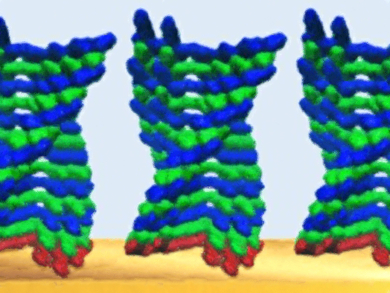Interfacial oligopeptides have been popular targets for biomimetic materials chemists, who are interested in tailoring surface properties such as wettability, biocompatibility, and cell adhesion.
Pol Besenius, University of Mainz, Germany, Bart Jan Ravoo, University of Münster, Germany, and colleagues have developed a modular synthetic strategy that uses supramolecular alternating copolymerization of peptide monomers in order to grow surface-grafted peptide nanorods on gold surfaces. Reminiscent of solid-phase synthesis approaches, the sequential addition of anionic and cationic monomers allows the stepwise growth of supramolecular copolymers.
Charge regulation passivates the growing chain end of the polymer and, therefore, slows down the kinetics of the self-assembly process. This allows the formation of surface-confined and kinetically trapped chiral supramolecular polymers with a tunable height in the range of 5–19 nm, a defined hydrogen-bonded secondary structure, and precise lateral positioning in micropatterns. The high fidelity of the surface-confined polymerization could open up opportunities for the development of chiral interfaces and adaptive biomaterials.
- Kinetically Controlled Sequential Growth of Surface-Grafted Chiral Supramolecular Copolymers,
Hendrik Frisch, Eva-Corinna Fritz, Friedrich Stricker, Lars Schmüser, Daniel Spitzer, Tobias Weidner, Bart Jan Ravoo, Pol Besenius,
Angew. Chem. Int. Ed. 2016.
DOI: 10.1002/anie.201601048




